
This Unit is Transdisciplinary reinforcing the importance of the honeybee.
- Subject:
- Applied Science
- Environmental Science
- Life Science
- Mathematics
- Material Type:
- Activity/Lab
- Date Added:
- 03/06/2019

This Unit is Transdisciplinary reinforcing the importance of the honeybee.
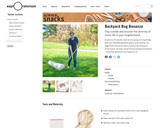
Step outside and discover the diversity of insect life in your neighborhood. Insects are the world’s most diverse group of living things, with over 950,000 identified species and counting. You might think that you’d need to travel to the Amazon to study insects, but they can be found practically everywhere—including right where you happen to be.
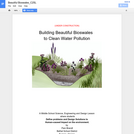
In this 1-2 week engineering design lesson, students will design and build water filters out of natural materials to simulate a filter system (bioswales) that cleans storm-water runoff before it soaks into the ground or enters a city’s storm-drain system. Their ultimate goal is to determine the combination and sequence of materials that best clean polluted water. Using materials easily found in pet stores and garden centers, students use the scientific method, students design to test and retest their designs and record, display and analyze their results.

This ZOOM video segment shows how to create a self-contained environment and explores evaporation, condensation, and precipitation.
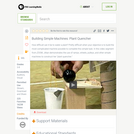
In this video segment from ZOOM, Jillian explains how her simple machine uses marbles, levers, flowing sand, and a spinning wheel to water a plant.

Microorganisms in action!

You are preparing your family’s emergency kits in case there is a need to leave your home quickly, or stay in your home without electricity or water. You need to be able to create an emergency supply kit that includes a lightweight water filtration device that is low cost. This will provide you with clean water regardless of your water source.
In this project, you will gain knowledge of natural disaster preparedness through the Red Cross Pillowcase project. You will research and experiment with the water cycle to learn how water is naturally filtered. You will then design and build a water filtration device that could filter water in an emergency situation.

Build a pinecone birdfeeder for your yard.
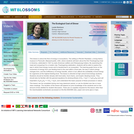
This lesson is about the flow of energy in ecosystems. The setting is Plimoth Plantation, a living history museum in Plymouth, Massachusetts, USA, where students will learn about the first Thanksgiving meal in America, celebrated in 1621 by early American settlers and Wampanoag Indians. By examining this meal and comparing it to a modern day Thanksgiving celebration, students will be able to explore the way in which food energy moves and is transformed in an ecosystem. The learning goals focus on the movement of energy from one feeding level to the next within a food web, the way in which energy changes form, and the inefficiency of energy transfer, which in turn affects the availability of food energy for organisms at the highest feeding level. The lesson is directed at high school level biology students. Students should be familiar already with food webs, food chains, and trophic (feeding) levels. They should also be familiar with the general equations for photosynthesis (CO2 + H2O => C6H12O6) and cell respiration (C6H12O6 => CO2 + H2O), and understand the basic purpose of these processes in nature. This lesson can be completed during one long classroom period, or can be divided over two or more class meetings. The duration of the lesson will depend on prior knowledge of the students and on the amount of time allotted for student discussion. There are no supplies required for this lesson other than the downloadable worksheets (accessed on this BLOSSOMS site), paper and some glue or tape.
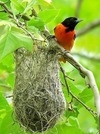
We have a problem to solve in our school community – litter on our school grounds. We know that this litter can have negative effects on our local bird populations. Sometimes problem-solvers, such as engineers, study natural phenomena to figure out solutions to problems.
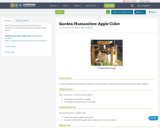
In this 6th grade seasonal lesson, students use teamwork to collectively press cider and learn about apples.
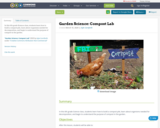
In this 6th grade Science class, students learn how to build a compost pile, learn about organisms needed for decomposition, and begin to understand the purpose of compost in the garden.
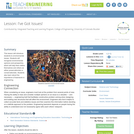
This lesson will introduce students to environmental issues. Students will recognize environmental opinions and perspective, which will help them define themselves and others as either preservationists or conservationists. Students also learn about the importance of teamwork in engineering.
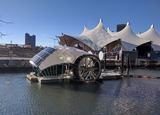
What's the Matter with Trash?Have you ever wondered what happens to trash once you throw it away? You may know that it goes to a dumpster or that the trash collectors come and get it. But, what happens then? Some of the items you throw away will break down into smaller parts, some might get heated in fire, and others will get buried underground in landfills and might never break down at all! Trash and the many ways humans “get rid” of it can cause a number of health issues for the community. You will explore the properties of materials we throw away and how you can make your community cleaner and healthier by learning to recycle, reuse, and reduce waste. You will then influence your community by convincing others to improve solid waste management.
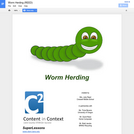
This project will raise student awareness of the problem of waste and waste management in our community. As we progress through the unit the goal is to reduce the amount of waste that our school produces. There are many ways to do this but the most unique aspect is to reduce biodegradable waste from our cafeteria through the process of vermicomposting. Students will design and create worm bins to reduce our cafeteria waste. The project will take a couple of weeks for the content and the construction of worm bins and then we will monitor our worm bins throughout the school year.

The world’s youth will have a significant role to play if we are to bring about the widespread behavioural change needed to shift towards more sustainable lifestyles and consumption habits. It is important for young people to understand that behind over-consumption lies increased exploitation of resources, rising poverty, widening inequalities and persistent conflicts, all of which will worsen with climate change and eventually will minimize their opportunities for a better and sustainable future. The poorest of the poor, those who cannot consume enough to meet their basic needs, are the worst hit by climate change. Most of these are young people under 24, who make up nearly half of the world’s population, with most living in developing countries.